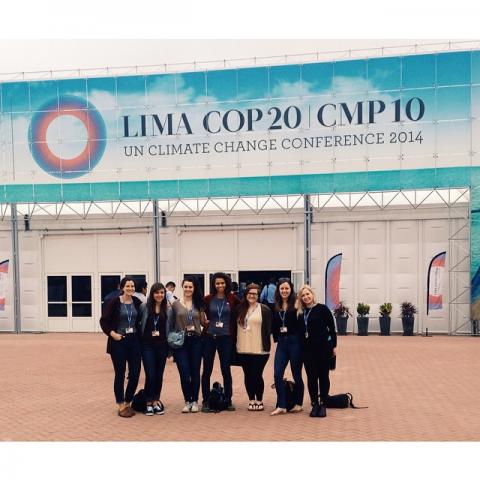Much has changed since I wrote my last blog. We are a quarter of the way into the negotiations here at COP 20 in Lima. As we are near the end of day 4 of the UN Climate Talks, I’d like to reflect on the past few days.
This week has provided a steep learning curve for me. On any given day, the meetings schedule alone has at least 80 events between 8 a.m. and 8 p.m. Additionally, we attend stakeholder meetings with representatives from the Canadian government, daily briefings, as well as additional meetings with other youth delegations and groups present in Lima.
In the daily stakeholders meetings with the Canadian government, we are consistently seeing questions around Canada’s commitments for COP 21 in Paris. National commitments come largely in the form of Intended Nationally-Determined Commitments (INDCs), proposals on which are due in March 2015. When an observer asked the Canadian representative about whether or not they would make the deadline and expressed concerns that Canada would be one of the only high emitting nations in the world to miss the deadline, the representative assured us they would complete the application in the first quarter. Let’s hold them to that.
An [In]equitable Climate Treaty in Paris 2015?
World leaders have been touting COP 20 as the conference to pave the road to a legally binding treaty in Paris in 2015. By Day 4, however, divisions between the Global North and Global South are making themselves known, particularly around the ADP (Ad hoc Working Group on the Durban Platform) also known as the fundamental base for negotiations to get to Paris. With many of us pushing for equity to be at the heart of next year’s climate deal, it is disheartening to see the degree of division among member states. Particularly upsetting is that it is the so-called “developed” countries that seem to be actively working against equity thus far.
We are already seeing problematic comments from the EU, U.S., Australia and Switzerland — supported by Canada and New Zealand — on climate financing. Likewise there has been strong pushback on linking climate finance through the Green Climate Fund and the Adaptation Fund to international law. This is deeply troubling as it essentially opens the door for countries to set their own terms for funding adaptation and mitigation efforts in the Global South.
As recently as this morning, the Australian representative said that Australia will use its own means to fund climate “aid” to so-called “developing” nations and will stand firm on its refusal to provide funding through the Green Climate Fund. This translates to less money for the most vulnerable peoples in the most vulnerable countries to protect themselves against the effects of climate change.
Alternatively, the African Group, G77+China, and a number of countries from the Global South have spoken out strongly on the need for robust financial commitments from member states. The South African representative was particularly impressive in yesterday’s finance meetings, stating the need for meaningful and inclusive conversation around climate funding. They went on to say, quite poignantly, “If people don’t want to have a conversation lets just pack our bags and go home.”
Corporatization of COP
Corporate presence is certainly beginning to be felt as we near the end of the first week of meetings in Lima. On Wednesday and Thursday in our daily meetings with representatives from the Canadian government, a representative from Chevron was present. TransCanada Ltd. joined the stakeholder meeting today, the representative was curious as to whether Canada was favouring a 5- or 10-year term for the treaty in Paris.
Likewise, a representative from Shell sat on a panel put on by the IPCC hawking Carbon Capture and Storage (CCS) as the wave of the future. For my friends back home in Canada, many of you will be familiar with the Boundary Dam project in Saskatchewan, which just opened for business a month ago. Using the public-private partnership model, the project gobbled up some CAD$1.4 billion to retrofit one coal plant in the province — one. I encourage you to think of what $1.4 billion in subsidies and investments towards renewables could have done for that province. We can be sure that the corporate presence here at COP20 will continue to make itself known. There are a number of side events being put on by Shell, Chevron, the Global CCS Institute and others. Stay tuned for more on that.
For COP 20 to be successful, we need to lay the groundwork for an equitable and just treaty that takes into account more than just climate change mitigation, which is where the current process sits. A fair treaty balances mitigation with adaptation, capacity building, technology sharing, and adequate and predictable climate finance through the Green Climate and Adaptation Funds.
Actions at COP 20
The Canadian Youth Delegation participated in two actions yesterday, as part of the Youth and Future Generations Day.
The first action highlighted the unheard voices of future generations from around the world. There were two specific demands:
- That agreements are in line with having net zero fossil fuel emissions worldwide by 2050.
- That negotiations cease to be rooted in a discount rate that values impacts in present day over impacts in the future.
The second action was organized by SustainUS, an American youth delegation here at COP 20. It was the launch of a new initiative called the Climate Test that will highlight the climate policies, projects and politicians that are helping or halting progress.
In solidarity,
Aleah Loney and the Canadian Youth Delegation



